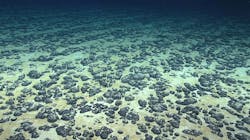ISA to start accepting deepsea mining applications in July
Offshore staff
KINGSTON, Jamaica – The International Seabed Authority (ISA) will start accepting applications in July from companies that want to mine the ocean floor, a decision that comes after the UN body spent the past two weeks debating standards for the new and controversial practice.
On March 31, the ISA closed two weeks’ worth of negotiations without approving rules and regulations to oversee deepsea mining amidst growing calls to pause, ban or place a moratorium on the nascent industry.
Nevertheless, the ISA’s governing council formulated a draft decision on March 30 that allows companies to file permit applications starting on July 9, a deadline set in motion by actions the island nation of Nauru took in 2021.
While the ISA has yet to receive an application for actual mining, more than 30 exploration licenses have been issued so far. Most of the exploration activity has focused on an area called the Clarion-Clipperton Fracture Zone, which spans 1.7 million square miles (4.5 million square kilometers) between Hawaii and Mexico. Exploration there has been occurring at depths ranging from 13,000 to 19,000 feet (4,000 to 6,000 meters).
There is reportedly ongoing debate within the ISA as to how the UN agency would approve or reject an application for a provisional license without guidance from a set of rules and regulations, according to an AP report. Further, there is as of yet no agreement on what a provisional license would allow.
And even if a provisional license is granted, it remains unclear as to whether that would be an actual green light for mining or just a provisional approval stating that the company or country cannot sign a contract with the ISA until a regulatory framework is created.
The council plans to meet virtually before July to debate further whether approval of such applications could be delayed once received, according to a Reuters report.
Interest in deepsea mining is being driven by the demand for critical minerals for the energy transition, including cobalt, copper, nickel, and manganese, which are key battery materials. The minerals rest on the seabed in the form of potato-sized rocks called polymetallic nodules, typically at depths of 4 to 6 kilometers.
Demand for minerals including lithium, cobalt and nickel is expected to increase from less than 10 million metric tons to some 150 million metric tons between 2020 and 2050, according to Columbia University’s Center on Global Energy Policy.
04.02.2023
